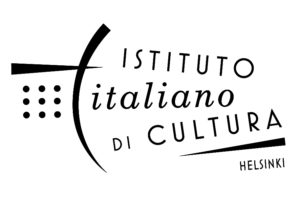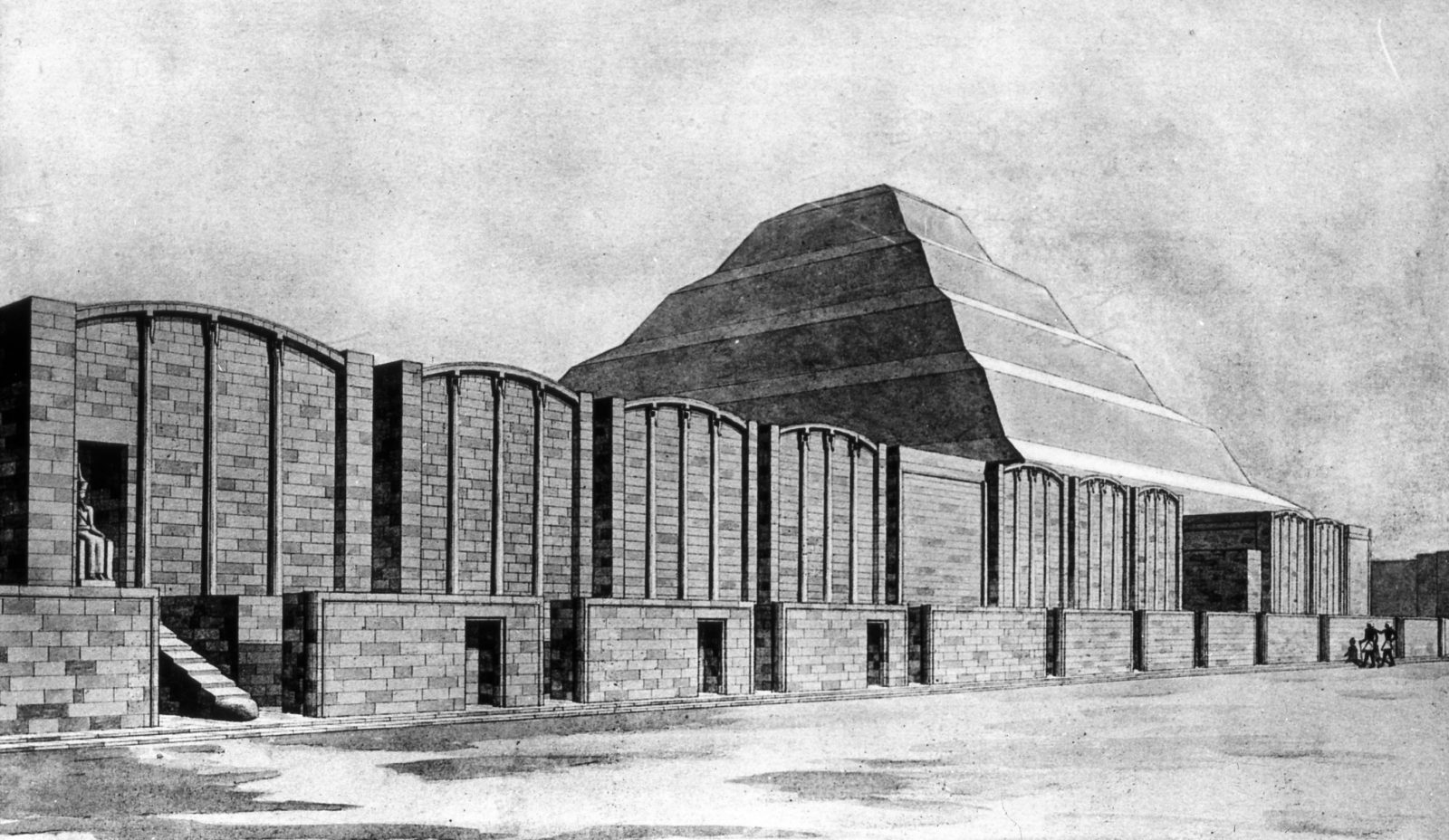
“The Egyptians’ drawing skills have not changed since the beginning, as has happened in the art of other nations. In Egypt, the art of drawing has remained the same for many centuries, that is, until the old national administration was dismantled. Until then, drawing seems hardly to have deviated from its pattern. This is clearly apparent in Egyptian statues, both those that depict actual human figures and those with symbolic animal heads. Although the sculptures are very skilfully executed, they are continuously reminiscent of the first works of the Etruscans and the Greek and, like them, are devoid of any concept of beauty […] What could they have known of grace? It was unknown to the Egyptians, just as according to Herodotus they were unaware of the three goddesses who represent grace. In this regard one can reiterate Strabo’s statement about their buildings, that they lacked both grace and painterliness […]”
Johann Joachim Winckelmann
Monumenti Antichi Inediti
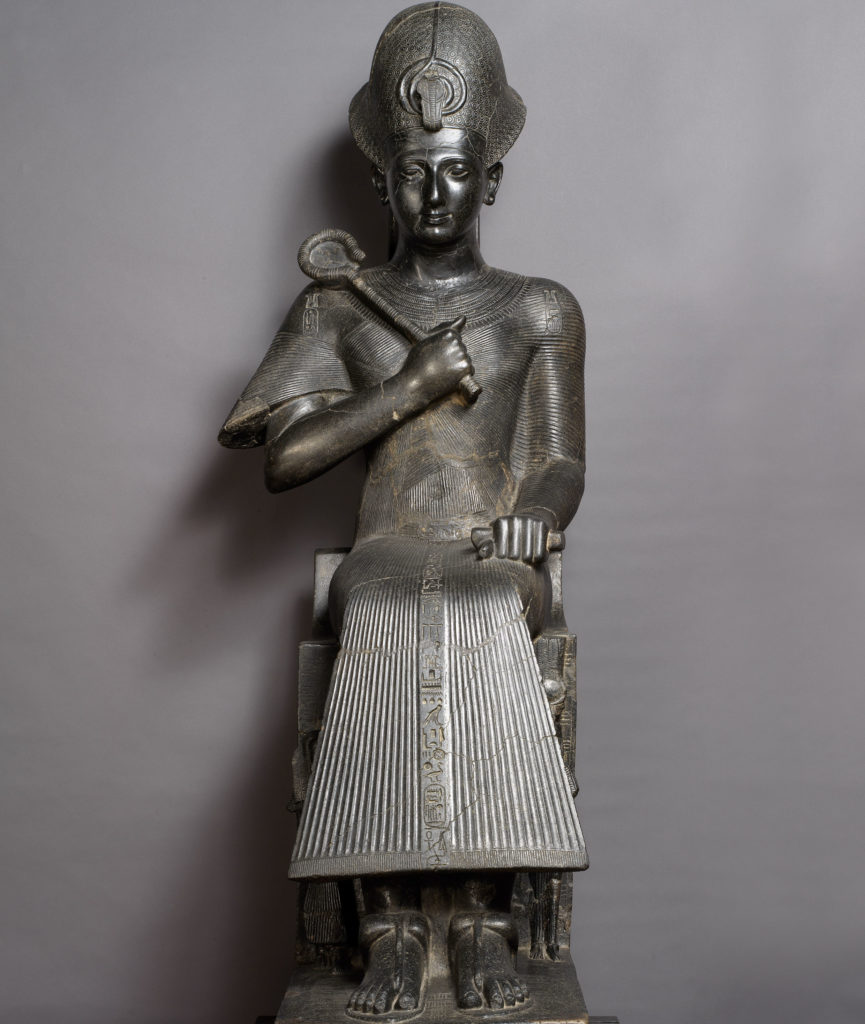
The appraisals of Egyptian art by German art historian and archaeologist Johann Joachim Winckelmann (1717–1768) in his book Monumenti Antichi Inediti (Unpublished Monuments of Antiquity, 1767) certainly did not smooth the way for this new branch of science, Egyptology. For years, researchers had to struggle to overcome the prejudice that ancient Egyptian art was not of the same value as that of Greece.
In fact Winckelmann came to his conclusion based on the few works of art he had seen in Europe. He never managed to visit Egypt, where he could have reconsidered his harsh judgement. Among many other works of art, Winckelmann did not, for instance, have a chance to marvel at the statue of Ramses II that Jean François Champollion dubbed the “Egyptian Apollo Belvedere”. Consul Bernardino Drovetti’s agents discovered the sculpture in 1818, and it is now in the collection of the Museo Egizio in Torino. Seeing it would certainly have forced Winckelmann to re-examine some of his notions and to foresee today’s prevailing view that ancient Egyptian art is on a par with Western art. By now, we are able to recognise and examine the sometimes quite fundamental changes and developments in styles and idioms that took place in Egyptian art over the centuries.
The story of Egyptian art stretches over four millennia, lasting significantly longer than that of other Mediterranean ancient cultures, such as the Sumerians, the Hittites, the Assyrians, the Scythians, the Persians or the Phoenicians – not to mention the ancient Greeks, whose “noble and exceptional” art only flourished for a few centuries.
Nor did the art that developed along the banks of the Nile over many millennia even become stagnated, but rather was in continuous flux. This immediately becomes clear when one compares the realistic sculptures of the Old Kingdom with the referential, stylised work of the last dynasties. This artistic development was also marked by stylistic crises and iconographic revolutions, which smouldered in a wide range of situations, environments and historical eras.
Ancient Egypt’s first monumental complex was built as a result of a genuine technical revolution. The tomb of Djoser (2667–2648 BCE), a pharaoh who ruled during the Third Dynasty, is completely unlike the buildings that preceded it, both in its architectonic system and its construction technology. One aspect that was new was the exclusive use of natural stone, an indestructible material that made it possible to build a tomb that would last forever. The rulers of the First (ca. 3000–2890 BCE) and Second (2890–2686 BCE) dynasties had built for themselves impressive “bench tombs” or mastabas (flat-roofed rectangular tomb structures). They were made of mudbricks, with stone used only for a few, specifically defined elements such as sculptures, cult chalices, false doors (through which the deceased’s Ka spirit could travel to the realm of the living and back) and steles.
The Djoser mortuary complex, in contrast, is surrounded by a wall, more than 1.5 kilometres long, which separates the sacred enclosure (temenos) from the rest of the area, enclosing a variety of buildings with different purposes. A gate leads into a court with structures associated with the Sed festival, which the monarch arranged to mark 30 years on the throne. The actual tomb structure (tumulus) is a step pyramid made up of six layered parallelepipeds, decreasing in size as they rise, in effect six mastabas stacked on top of each other. Adjacent to the building’s north face is a temple and an associated serdab chamber with an opening that offers a view outward but not inward. Inside is a statue of the pharaoh, accepting funerary gifts.
The Djoser step pyramid is one of those rare cases where the work of one artist – the king’s court architect and adviser Imhotep – and a significant portion of his role is a recognised fact. Usually artistic activity in Egypt was almost completely anonymous and its creators unknown. Often creatorship is impossible to specify as a work of art was seen as the result of group effort. Namelessness was not however merely a technical result but rather an ideological principle inherent to Egyptian art, which conveyed the expression of a certain leading class of society. In other words artists served as interpreters of society, even though their artistic work was sharply restricted. Thus a work of art reflected the worldview of the community in question.
The notion of “art for art’s sake” was completely alien to the Egyptians. For them, art had a precise goal, to bring to life that which an artist created by sculpting or painting. A sculpture shaped out of a boulder is as alive as the person that it represents. Such great potential exceeded the will of both the artists and the priests who recited the prayers that guided them into life. Therefore precautionary measures were often taken to ensure that the powers hidden within a statue did become unleashed. This was particularly done when they were associated with functions seen as threatening. Egyptian artists must therefore be examined as actors working within the world of magic and faith.
The dominant position of religion is a distinguishing feature that brought together art and literacy. Hieroglyphs were used over the course of millennia as consistent pictographic symbols. The Egyptians did not see any essential difference between drawing characters and painting works of art. The work of the scribe and the artist were equally creative activities. Drawing a hieroglyph or a human figure both magically calling them to life. For precisely this reason, the symbols depicting animals in pyramid texts were placed in such a way that they could not leave the inscriptions to which they belonged. For the same reason, during the Middle Kingdom (2055–1650 BCE), symbols representing dangerous beings such as snakes and demons were rendered harmless by depicting them as defective in some way.
In light of this, the staticity that seemingly dominated Egyptian art for millennia takes on quite a different meaning. The compulsive repetition of uniform, regulated iconographic models – such as a pharaoh defeating enemies, embracing spouses, a cross-legged scribe with an open papyrus in his lap among many others – does not reflect a lack of creativity, artistic sensitivity or sense of beauty, but rather a specific, significant ideological-religious need. The strict adherence to certain patterns did not however prevent the creation of significant works of art throughout the history of ancient Egypt, from the Old Kingdom through the Late Period. Nor did it exacerbate the “artistic” crises and revolutions, which must be interpreted while taking into consideration the prevailing cultural regulations. The possible derailment of the pictorial art idiom was not in itself, at least conceptually, in any way revolutionary, because it was most often an expression of a clear directive from the ruler. One example is the artistic reform of the so-called Amarna Period, which shaped the last phase of the 18th Dynasty.
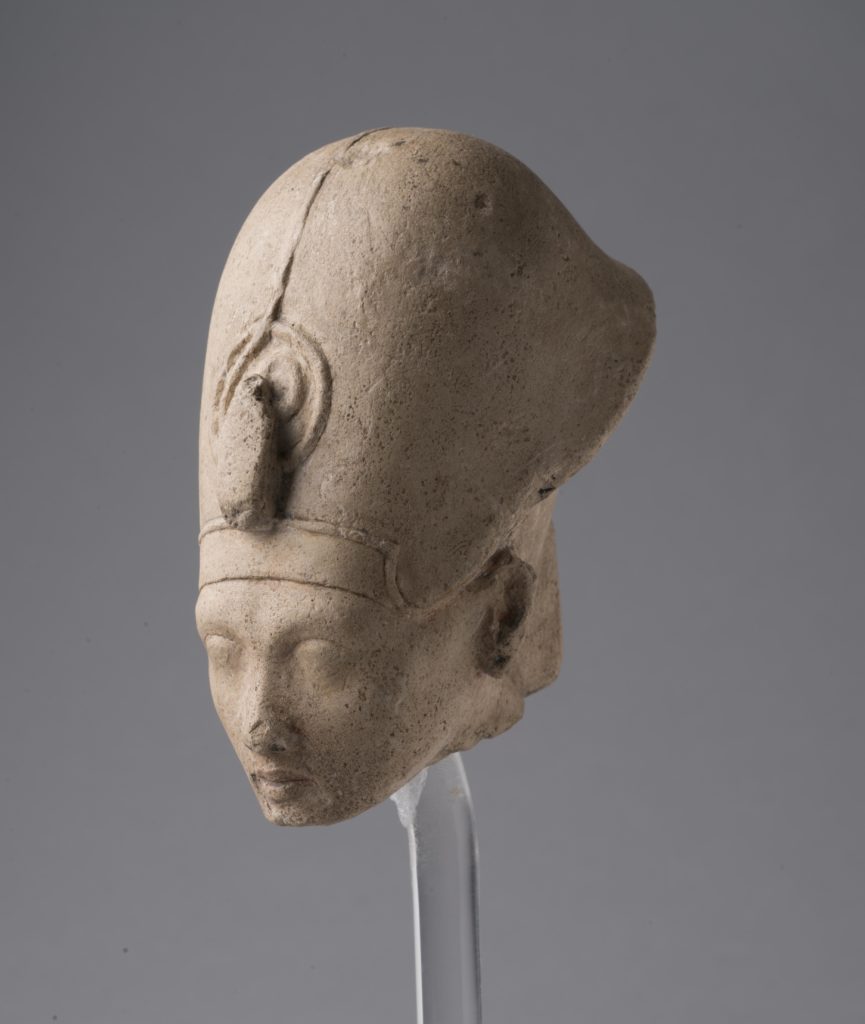
Pharaoh Amenhotep IV, who ruled Egypt during the late 18th Dynasty, changed his name to Akhenaten and imposed the cult of Aton as the dominant religion. Akhenaten’s reformations primarily meant an ideological change whereby everything centred on Aton, depicted as a sun disc, and his chosen king. The reformation did not intervene in the administrative system in any way, but it had a particularly noticeable impact on the field of art, resulting in a “dramatic” change in the visual arts of the New Kingdom (1550–1069 BCE). Painters and sculptors were given the appealing task of coming up with an entirely new idiom of visual expression.
It was then that the official realism began to give way to a more sensual realism, in which the softness of the human body was emphasised through the “wet cloth” technique. Akhenaten took this movement to such an extreme that realism turned into unnatural exaggeration. The emphasis of certain physical characteristics that expressed character and the shrinking of muscle mass was so pathologically clear in the gigantic statues of Osiris created by the sculptor Baki that the figures’ swollen bellies were even thought to show the bodily fluids that inflated Osiris’s decaying body.
Over the years the style softened yet remained exaggerated compared to the traditional rules (known as the canon). New subjects arose: in all situations and particularly in cult-related scenes, the family was always shown performing everyday activities, which created a deeply human atmosphere. Besides the chosen subject type, the works are startling in their iconographic decision to portray human figures as clumsy and unattractive, with large heads wobbling atop thin, curved necks. The elongated skulls and delicate limbs are repeated in relief images so extensively that this extreme style approach can in no way be considered the work of one individual artist. They must have been based on a precise order from a ruler: this blatant inelegance serves as unequivocal typification, through which the royal figures are clearly differentiated from the rest of humanity. The elevation of the king and his family to godliness entitled them to recognisable portraits, which could be used in cult practices.
A fascinating archaeological find is also linked to the reign of Akhenaten. Excavations in Amarna in 1902–1903 revealed the workshop of a sculptor named Thutmose and his apprentices. Found on the site were models for students to copy as well as incomplete sculptures. Undoubtedly the best known of them is the famous bust of Queen Nefertiti. Besides this portrait of Pharaoh Akhenatn’s spouse, the finds also include a series of plaster sculptures that were likely used for instruction purposes, including masks with extremely precise facial features of various individuals. The masks look so real that they were thought to be plaster masks made on the faces of dead – or even living – people, as the features clearly firmer than on death masks. In conclusion it is clear that the experimental art typical of the Amarna Period and the freedom of expression that the artists of the time seemingly enjoyed were actually the result of a precise, controlled ideological choice planned and carried out by the ruler.
The art of the Saite Period was also based on a corresponding ideological choice – albeit made in a completely different ethnic, geographic, historical and social situation. Sais, in the Nile Delta, was Egypt’s capital during the 26th Dynasty. The rulers of this era sought to restore Egypt’s independence. In the 7th century BCE, the country was ruled by monarchs whose worldview was expansive. They left seafaring and trading to the Phoenicians and formed such close political ties with the Greeks that a Greek city (polis) named Naucratis was established on Egyptian soil. The inhabitants worshipped Greek gods, entrusted judges to dispense justice and accepted ethnic groups that did not want to lose their original cultures and also represented models of civilisation that deviated completely from those of the locals.
The Saite Period of Egypt’s history was something utterly new, and certainly caused difficulties for artists, who until then had restricted themselves to orthodox iconography and cultural traditions. Forced to interact with other cultures, they completely lost touch with the world in which they lived, even to the extent that they were no longer able to analyse and embrace it. The results of their artistic work also indicates that artists were tired of linear forms and of the sensual art that had gained ascendancy for several centuries following the reforms of the Amarna Period. Now they took as their role models much earlier pictorial art with the cold, unemotional rationalism that had characterised the art of the Old and Middle Kingdoms. The choice of this approach led to an irreparable break with the recent past. This break should not be seen as equivalent to the Middle Ages’ divergence from antiquity, where the detachment occurred incrementally through the developments of Late Antiquity – in reality a tissue of art and culture was created during the Middle Ages that continued seamlessly on the basis of the preceding era. Rather it can be compared to the phenomenon that led to the birth of Renaissance art in the 15th century, which, in seeking to restore lost earlier values, detached itself sharply from the traditions of the immediately preceding era, nearly rejected them. It was indeed due to this correlation that Egyptologists referred to the era of Egyptian art that spans the 25th (747–656 BCE) and above all the 26th (664–525 BCE) dynasty as Renaissance of the pharaohs.

During this period, the concept of the model was developed, while the classic periods whose works of art should be copied were also specified. Egypt returned to a heyday of a blossoming economy as well as in art and intellectual activity. In this situation, intellectuals felt the need to reclaim their favoured golden age as a paragon. Egyptian artists did of course otherwise often take older monuments as models, but for the first time this replication did not include anything ideological. As a result of this renewed interest in the periods of ancient art, combined with ties to other Mediterranean cultures, Egyptian art adopted ‘Egyptified’ models from arts and crafts, which were basically formulaic reductions. Due precisely to this complex game, the most emblematic traits of the art of the time took hold. These included extreme austerity of form, which would nearly rival that of its forebears if it was not marked by a colder, albeit more consistent, stylistic reinvention. Because of its substance and colours, sculptors favoured natural stone, which led to a major technical advance: works were first prepared as plaster models, whose features were then exactly repeated in the completed sculpture.
Around the same time, the Saite rulers stirred up a powerful national feeling. It was born in response to the situation during the previous era, when the Egyptian throne was held by Upper Nubians from the southern part of the country, also known as the Kushite kings. Portrait painters abandoned realistic representation. In statues of the Saite kings, the facial features are idealised and the skin surface is so shiny that suggests a desire to challenge the capabilities of natural stone. The eyes are stretched into unnatural shapes and the lightly grooved eyebrows curve downward on each side of the forehead. Undoubtedly, the feature that predominantly defined the pharaohs’ faces was however the upwardly curving mouth, which formed an enigmatic half-smile referred to as the “Saite smile” by contemporary Egyptologists. As a result, each portrait seems to portray a benevolent ruler who does not look down on the people’s expressions of adulation.
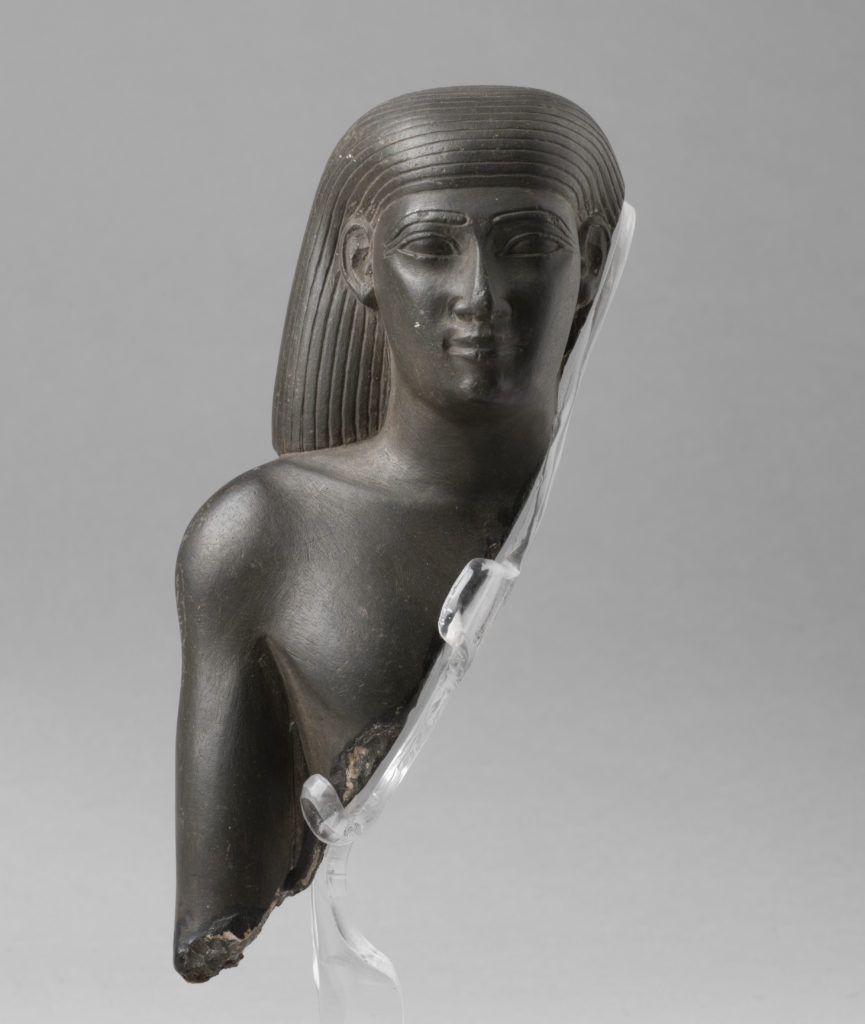
Quite soon, this unique feature was also adopted in privately commissioned sculptures. These works show perfect execution, a degree of solemn formalism and archaicising references to a glorious past. The tendency toward an archaicising form of expression, in other words one that imitates the past, can be seen particularly in the types of wigs, the portrayal of the eyebrows and the simple surface forms. However, there was also something extremely elaborate, excessively smooth and polished, that suggests a different kind of origin, such as the artisans’ workshops that produced funerary artefacts and sarcophagi, which were once again carved from stone.
The uniqueness of Saite Period art is not merely based on its accentuated glorification of its archetypes from the past. Behind this was also awareness of an ancient cultural heritage that had not previously been examined. This heritage becomes a value to be preserved and cherished, particularly when one takes into consideration that it was specifically during the end of this era that Egyptian civilisation lost the most crucial prerequisites for its status on the stage of antiquity in the Middle East. Naturally, its art did not end there, but over the following two or three centuries, artists sculpted and painted according to the traditional ways, repeating worn-out formulas that were no longer enlivened by an interest in ancient art.
Text: Paolo Marini, curator, Museo Egizio
Translation: Wif Stenger
Bibliography
The literature on Egyptian art is vast. The following works are suggested for an introduction to the subject:
AA. VV., The Visual Arts, in Lloyd, A. B. (ed.), A Companion to Ancient Egypt, United States 2015, pp. 779–1064.
Aldred, C., Egyptian Art, London 1980.
Bothmer, B.V., H. de Meulenaere, H. W. Müller (ed.), Egyptian Sculpture of the Late Period: 700 BC to AD 100, New York 1960.
Donadoni, S., Arte Egizia, Torino 1966.
Hartvig, M. K., (ed.), A Companion to Ancient Egyptian Art, United Kingdom 2015.
Museo Egizio, Modena 2015.

